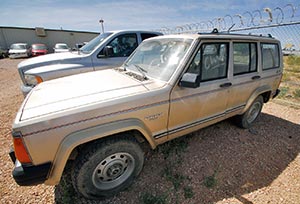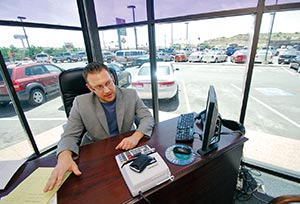Cash for Clunkers not helping Natives
By Cindy Yurth
Tséyi' Bureau
GALLUP, Aug. 13, 2009


(Special to the Navajo Times - Donovan Quintero)
TOP: A 1990 Jeep Cherokee that has seen better days now sits parked at the Ed Corleys Dodge Chrysler-Jeep parking lot in Gallup. The Jeep was traded in for a newer vehicle under the "Cash for Clunkers' program.
BOTTOM: Mark Becher, manager at Ed Corley Dodge Chrysler-Jeep in Gallup, explains how the "Cash for Clunkers' program works.
At first glance, President Obama's "Cash for Clunkers" program seems like a godsend for the rez.
Bring your aging gas-guzzler to a local dealership, and the government will pay you up to $4,500 to get into a brand new vehicle.
Alas, few Navajos have been able to take advantage the program, say the four major car dealers in Gallup, where Natives comprise about 80 percent of the auto trade.
Since July 24, when the program officially started, the dealers have taken in a total of 22 "clunkers," and most have yet to be reimbursed by the government for the trade-in credit offered to customers.
There are several reasons why the program doesn't work well in these parts.
A big obstacle, said Sales Manager Mark Becker at Ed Corley Dodge, is that the vehicle taken as a trade-in has to be registered and insured.
"I have a lot of people come and tell me, 'I've got a clunker sitting in the front yard,'" Becker said. "Well, no, the program doesn't work that way. It's designed to get clunkers off the road, not out of people's yards."
Another problem is that the program requires buyers to trade for a vehicle that gets between two and four miles per gallon better gas mileage than their current vehicle, which generally means going for something smaller.
It's a concession most Navajos aren't willing to make, said Marty Menapace, sales manager at Rico Auto Complex, because they use their vehicles to haul water, hay and other heavy cargo.
"Our biggest seller is a half-ton pickup," Menapace said. "That's the way it's always going to be."
The only half-ton that qualifies under the program is the Dodge Ram 1500, which is what all three clunkers customers at Corley ended up buying, Becker said.
Also, while some city dwellers may be laboring under the misperception that the rez is overrun with clunkers, that's actually the furthest thing from the truth.
""The folks that are really making out under Cash for Clunkers are folks who have vehicles from the 1980s," Becker explained. "If you look around the reservation, there aren't too many cars that age, for the simple reason that driving on the reservation eats up cars pretty fast."
For instance, one of Becker's recent customers traded in a 2002 Dodge Ram. It had 250,000 miles on it.
"We have Navajos come in here who trade in their cars every two or three years, and they need to," he said.
If the Cash for Clunkers program is not exactly a godsend to local car buyers, it's been a downright headache for the dealers.
After taking just two clunkers under the program, Steve Gurley of Gurley Motors opted out.
"It took over a week just to get the paperwork submitted to the government," he said. "I finally got two submitted around the first of this week. As of 2:30 this (Friday) afternoon, they're still showing 'pending approval.'"
According to the government's own figures, 219,000 applications have been submitted for the Cash for Clunkers program nationwide and only 1,600 rebates had been paid as of last week.
A lot of applications, Gurley said, are rejected for various reasons - but meanwhile the dealer is required to permanently disable the car's engine and stamp "C4C" on the title so it can't be resold.
"You're bettin'," he said. "If they reject it, I'm stuck with a car that's motor is destroyed, a title that's no good and a customer who's mad at me."
Even getting familiar with the program's ins and outs takes time. There are 136 pages of rules that "you darn near have to be a lawyer to read," according to Gurley.
As an alternative, he's created his own version of Cash for Clunkers, where customers get up to $3,500 on a trade-in and "the only rules are there has to be a clear title and you have to drive it in here," Gurley said.
On the other end of the spectrum is Glen Benefield, sales manager at Amigo Toyota, who has taken in 15 vehicles under Cash for Clunkers.
"It's a bit cumbersome," Benefield admitted, "but it's getting a lot of old vehicles off the road and it's getting people from being upside-down to right-side-up."
One thing all the dealers like about Cash for Clunkers is that it's bringing people in.
"Ninety percent of the people who have been coming in lately, that's the first thing they ask about," said Menapace.
"We'll run the numbers and say, 'Well, you don't qualify, but here's what we can do for you,'" added Becker. "There are a lot of good deals out there now, with or without Cash for Clunkers."
"It was a kick in the pants when we really needed it," Benefield said.
But even that worries Gurley, who says the program is disrupting what he calls "the natural rhythm" of the car business.
"People have a cycle as to when they buy a new car," he said. "For some people, it's every 10 years, for other people it's every three or four years. All this program is doing is making people come in a little earlier than they would have otherwise. What's going to happen in the next five years? That's my question."
To see if your vehicle qualifies as a "clunker," visit www.fueleconomy.gov.

